实证研究型论文提纲写法Research Paper Outline
论文提纲怎么写

论文提纲怎么写论文提纲的写作可以按照以下步骤进行:1.确定研究领域和问题:首先明确研究领域和问题,确定你要进行研究的主题和目的。
这可以包括你对该领域现有研究的了解和对尚未解决问题的兴趣。
2.制定研究目标和问题:根据你的研究领域和问题,明确你的研究目标和目标问题。
研究目标应该是明确和具体的,可以将其分解成几个可以量化或操作的研究问题。
3.构建论文结构:根据研究目标和问题,构建论文的整体结构。
通常包括引言、文献综述、研究方法、数据分析和结果、讨论和结论等部分。
确保每个部分都能清晰地传达你的研究目标和解决问题的方法。
4.确定章节和段落内容:对于每个主要部分,确定下一级的章节和段落。
在每个部分中,列出你要讨论的主题和子主题,并排列它们的逻辑次序。
确保每个章节和段落都有具体的主题句并支持你的研究目标。
5.细化内容提纲:对于每个章节和段落,进一步细化你要讨论的内容。
可以使用符号、编号或子标题来组织你的提纲,并确保每个主题都能被清晰地展开。
6.完善论文框架:根据你的提纲,进一步完善你的论文框架。
确保每个章节和段落之间的逻辑关系清晰可见。
如果有需要,可以在不同章节之间添加必要的过渡段。
7.补充细节:在完成框架之后,补充每个章节和段落中的细节内容,包括相关的理论支持和实证研究。
确保你的论文能提供足够的证据来支持你的论点和结论。
8.修订和完善:最后,仔细审查和修订你的提纲,确保逻辑清晰、内容完整。
可以将提纲与你论文的目的和结构进行对比,确保提纲能全面覆盖你的研究内容。
一个好的提纲可以为你的论文提供一个清晰的框架,帮助你组织思路和表达内容。
记得提纲应该是灵活的,可以根据你的研究进展进行修改和调整。
希望以上步骤能对你写作提纲提供一些帮助。
英语论文提纲格式文档2篇
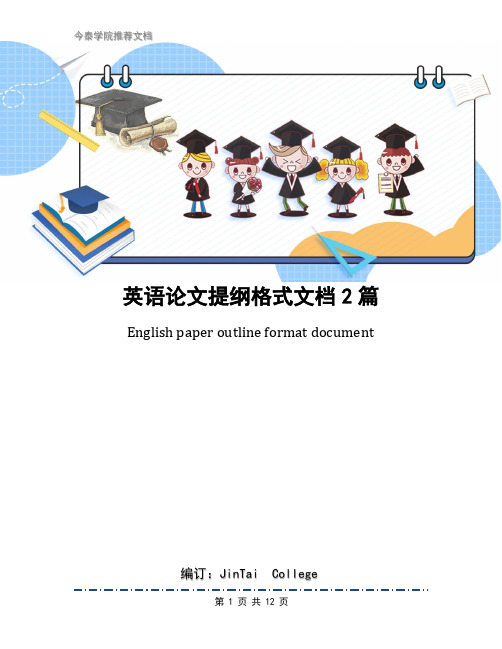
英语论文提纲格式文档2篇English paper outline format document编订:JinTai College英语论文提纲格式文档2篇前言:论文格式就是指进行论文写作时的样式要求,以及写作标准,就是论文达到可公之于众的标准样式和内容要求,论文常用来进行科学研究和描述科研成果文章。
本文档根据论文格式内容要求和特点展开说明,具有实践指导意义,便于学习和使用,本文下载后内容可随意调整修改及打印。
本文简要目录如下:【下载该文档后使用Word打开,按住键盘Ctrl键且鼠标单击目录内容即可跳转到对应篇章】1、篇章1:英语论文提纲格式文档2、篇章2:大学英语论文提纲格式规范篇章1:英语论文提纲格式文档一、课题研究目的意义随着经济全球化趋势的进一步增强,英语日益成为我国对外开放和与各国进行经济文化等方面交流的重要工具,因此如何改进英语教学已成为人们街谈巷议的话题和举目关注的焦点。
我校经过三年多的实践和研究,已初步确立了小学英语活动体系的目标和模式,实践证明小学英语活动体系是必要的,可行的,普遍适应小学生身心发展规律。
近年来我国基础外语教育有了很大的发展,然而,在大力发展基础英语教育的同时。
很多教师却不同程度地忽略了儿童心理认知的特点。
综观我们的外语课堂教学,教师的教学理念与社会的要求还有较大的差距。
在传统的教学方法的影响下,教师仍占去课堂大部分时间,导致为学生成为语言知识的消极接受者。
因而从更高的层面上来反思小学英语教学,真正的把小学英语活动体系应用到日常英语教学与英语活动中去就显得尤为重要。
为了改变现状,更好地贯彻教育部关于《英语课程标准》的精神,培养学生交际运用语言的能力,实现知识、技能向能力的转化,培养学生在英语活动中生动活泼`积极主动地发展,我们提出了《小学英语活动的实效性研究》的课题研究。
二、理论依据和研究目标理论依据:活动型教学方式符合外语教学理论中的“情感过滤”假设。
有利于调节儿童的情感因素。
10步搞定ResearchPaper
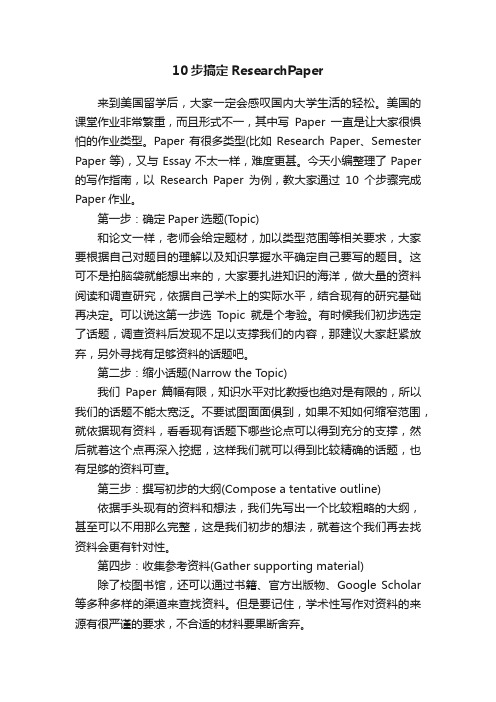
10步搞定ResearchPaper来到美国留学后,大家一定会感叹国内大学生活的轻松。
美国的课堂作业非常繁重,而且形式不一,其中写Paper一直是让大家很惧怕的作业类型。
Paper有很多类型(比如Research Paper、Semester Paper等),又与Essay不太一样,难度更甚。
今天小编整理了Paper 的写作指南,以Research Paper为例,教大家通过10个步骤完成Paper作业。
第一步:确定Paper选题(Topic)和论文一样,老师会给定题材,加以类型范围等相关要求,大家要根据自己对题目的理解以及知识掌握水平确定自己要写的题目。
这可不是拍脑袋就能想出来的,大家要扎进知识的海洋,做大量的资料阅读和调查研究,依据自己学术上的实际水平,结合现有的研究基础再决定。
可以说这第一步选Topic就是个考验。
有时候我们初步选定了话题,调查资料后发现不足以支撑我们的内容,那建议大家赶紧放弃,另外寻找有足够资料的话题吧。
第二步:缩小话题(Narrow the T opic)我们Paper篇幅有限,知识水平对比教授也绝对是有限的,所以我们的话题不能太宽泛。
不要试图面面俱到,如果不知如何缩窄范围,就依据现有资料,看看现有话题下哪些论点可以得到充分的支撑,然后就着这个点再深入挖掘,这样我们就可以得到比较精确的话题,也有足够的资料可查。
第三步:撰写初步的大纲(Compose a tentative outline)依据手头现有的资料和想法,我们先写出一个比较粗略的大纲,甚至可以不用那么完整,这是我们初步的想法,就着这个我们再去找资料会更有针对性。
第四步:收集参考资料(Gather supporting material)除了校图书馆,还可以通过书籍、官方出版物、Google Scholar 等多种多样的渠道来查找资料。
但是要记住,学术性写作对资料的来源有很严谨的要求,不合适的材料要果断舍弃。
第五步:资料整理(Read and review your documentation)当我们收集了足够的资料,如果不妥善整理,试图写的时候再找的话,你的论文写作效率将大大降低。
如何写好大学论文的实证研究部分
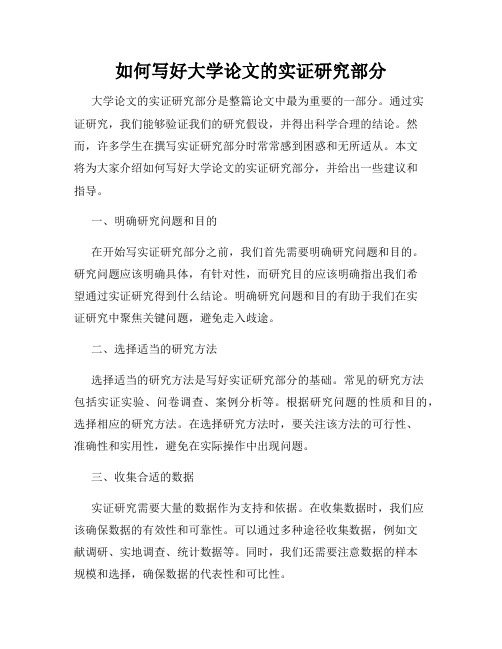
如何写好大学论文的实证研究部分大学论文的实证研究部分是整篇论文中最为重要的一部分。
通过实证研究,我们能够验证我们的研究假设,并得出科学合理的结论。
然而,许多学生在撰写实证研究部分时常常感到困惑和无所适从。
本文将为大家介绍如何写好大学论文的实证研究部分,并给出一些建议和指导。
一、明确研究问题和目的在开始写实证研究部分之前,我们首先需要明确研究问题和目的。
研究问题应该明确具体,有针对性,而研究目的应该明确指出我们希望通过实证研究得到什么结论。
明确研究问题和目的有助于我们在实证研究中聚焦关键问题,避免走入歧途。
二、选择适当的研究方法选择适当的研究方法是写好实证研究部分的基础。
常见的研究方法包括实证实验、问卷调查、案例分析等。
根据研究问题的性质和目的,选择相应的研究方法。
在选择研究方法时,要关注该方法的可行性、准确性和实用性,避免在实际操作中出现问题。
三、收集合适的数据实证研究需要大量的数据作为支持和依据。
在收集数据时,我们应该确保数据的有效性和可靠性。
可以通过多种途径收集数据,例如文献调研、实地调查、统计数据等。
同时,我们还需要注意数据的样本规模和选择,确保数据的代表性和可比性。
四、合理分析数据在分析数据时,我们应该使用适当的统计方法和分析工具。
可以使用SPSS、Excel等软件进行数据处理和统计分析。
在分析数据时,要确保数据的可靠性和准确性。
同时,要根据研究问题和目的,选择合适的分析方法,并对结果进行合理解释和推断。
五、借助图表展示结果为了更加清晰地表达实证研究结果,我们可以借助图表对数据进行展示。
图表可以帮助读者直观地理解和比较数据,更好地理解我们的研究结论。
在使用图表时,要保证图表的准确性和美观性,合理选择图表类型和标注说明。
六、准确陈述和解读结果在实证研究部分中,我们需要准确陈述和解读实证研究的结果。
陈述结果时要注意使用准确的数据和统计指标,避免主观臆断或夸大其词。
解读结果时要客观分析,理性评价,将结果与研究问题和目的相结合,得出合理的结论。
如何撰写一篇具有实证研究价值的大学论文
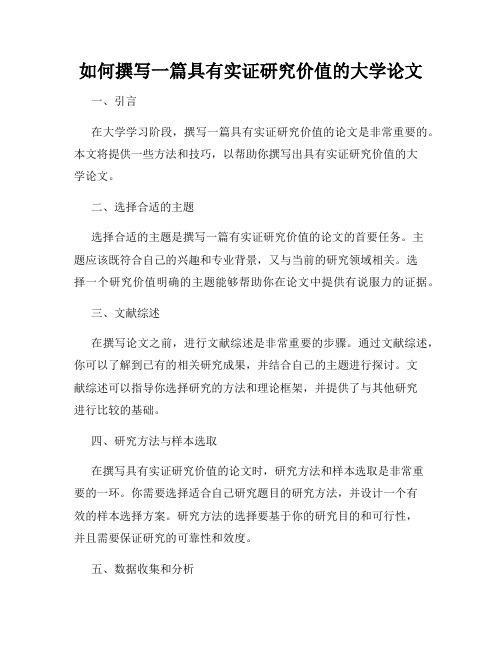
如何撰写一篇具有实证研究价值的大学论文一、引言在大学学习阶段,撰写一篇具有实证研究价值的论文是非常重要的。
本文将提供一些方法和技巧,以帮助你撰写出具有实证研究价值的大学论文。
二、选择合适的主题选择合适的主题是撰写一篇有实证研究价值的论文的首要任务。
主题应该既符合自己的兴趣和专业背景,又与当前的研究领域相关。
选择一个研究价值明确的主题能够帮助你在论文中提供有说服力的证据。
三、文献综述在撰写论文之前,进行文献综述是非常重要的步骤。
通过文献综述,你可以了解到已有的相关研究成果,并结合自己的主题进行探讨。
文献综述可以指导你选择研究的方法和理论框架,并提供了与其他研究进行比较的基础。
四、研究方法与样本选取在撰写具有实证研究价值的论文时,研究方法和样本选取是非常重要的一环。
你需要选择适合自己研究题目的研究方法,并设计一个有效的样本选择方案。
研究方法的选择要基于你的研究目的和可行性,并且需要保证研究的可靠性和效度。
五、数据收集和分析数据的收集和分析是实证研究的核心部分。
你需要根据你的研究方法,收集到具有代表性的数据,并进行科学的数据分析。
分析结果应该能够回答你的研究问题并支持你的研究假设。
数据分析的结果应该清晰地呈现在论文中,并配以图表等可视化的展示方式。
六、结果与讨论在撰写结果与讨论部分时,你需要对你的研究结果进行准确的描述,并从中获得有实证研究价值的结论。
你需要分析自己的研究结果是否与之前的研究成果一致,以及对研究领域的贡献。
在讨论部分,你可以进一步解释你的结果,并提出对未来研究的建议。
七、结论在撰写结论部分时,你需要总结你的研究工作,并对论文的研究价值进行概括。
结论应该简明扼要,并回答你的研究问题。
你可以重点强调你的研究对该领域的贡献,并提出自己对未来研究方向的建议。
八、参考文献撰写完一篇具有实证研究价值的论文后,你需要在文章末尾列出参考文献。
参考文献应该规范地引用,并按照所使用的引用格式进行排版。
九、结语撰写一篇具有实证研究价值的大学论文是一项充满挑战性的任务。
经济学实证论文提纲
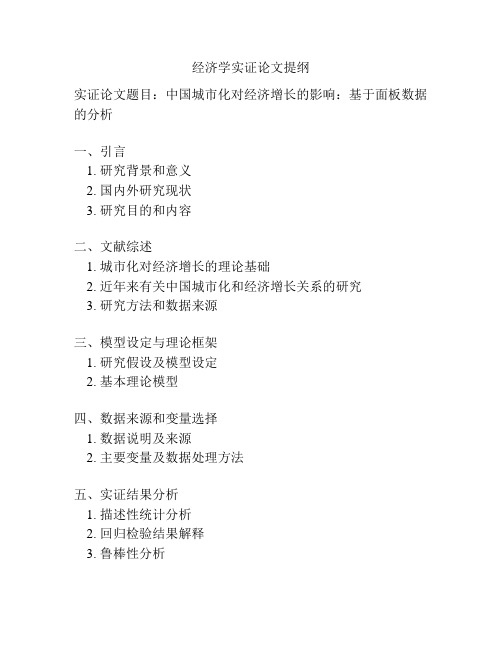
经济学实证论文提纲
实证论文题目:中国城市化对经济增长的影响:基于面板数据的分析
一、引言
1. 研究背景和意义
2. 国内外研究现状
3. 研究目的和内容
二、文献综述
1. 城市化对经济增长的理论基础
2. 近年来有关中国城市化和经济增长关系的研究
3. 研究方法和数据来源
三、模型设定与理论框架
1. 研究假设及模型设定
2. 基本理论模型
四、数据来源和变量选择
1. 数据说明及来源
2. 主要变量及数据处理方法
五、实证结果分析
1. 描述性统计分析
2. 回归检验结果解释
3. 鲁棒性分析
六、结论与政策建议
1. 总结研究结果
2. 政策启示和建议
3. 不足之处及后续研究方向
七、参考文献
注:实证论文的提纲应包含完整的研究框架和内容,每部分的具体细节可以根据具体研究内容和数据情况进行适当调整和完善。
申论作文调研提纲模板范文

申论作文调研提纲模板范文英文回答:Research Proposal Outline Template。
I. Introduction。
Background information on the research topic。
Statement of the research problem。
Research objectives。
II. Literature Review。
Overview of existing research on the topic。
Identification of gaps in the literature。
Theoretical framework for the research。
III. Research Methodology。
Research design (quantitative, qualitative, or mixed methods)。
Data collection methods (surveys, interviews, focus groups, etc.)。
Sampling strategy。
Data analysis techniques。
IV. Data Analysis and Interpretation。
Explanation of the data analysis process。
Presentation of research findings。
Discussion of the implications of the results。
V. Conclusions and Recommendations。
Summary of the research findings。
Recommendations for future research or action based on the results。
Chinese 回答:调研提纲模板范文。
论文提纲怎么写范文
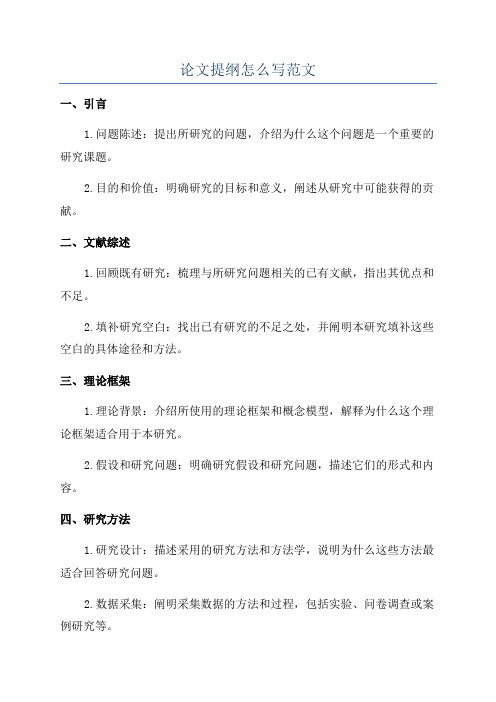
论文提纲怎么写范文一、引言1.问题陈述:提出所研究的问题,介绍为什么这个问题是一个重要的研究课题。
2.目的和价值:明确研究的目标和意义,阐述从研究中可能获得的贡献。
二、文献综述1.回顾既有研究:梳理与所研究问题相关的已有文献,指出其优点和不足。
2.填补研究空白:找出已有研究的不足之处,并阐明本研究填补这些空白的具体途径和方法。
三、理论框架1.理论背景:介绍所使用的理论框架和概念模型,解释为什么这个理论框架适合用于本研究。
2.假设和研究问题:明确研究假设和研究问题,描述它们的形式和内容。
四、研究方法1.研究设计:描述采用的研究方法和方法学,说明为什么这些方法最适合回答研究问题。
2.数据采集:阐明采集数据的方法和过程,包括实验、问卷调查或案例研究等。
3.数据分析:说明如何对数据进行分析和解读,使用的方法和模型。
五、实证研究结果1.数据描述:对采集到的数据进行描述和统计,呈现实证结果。
2.结果分析:对实证结果进行解读和分析,探讨是否支持研究假设或解答研究问题。
六、讨论和结论1.结果解释:从理论和实践两方面解释研究结果,说明所获得的结论和发现的意义。
2.局限性和贡献:讨论研究的局限性和不足之处,同时强调研究的贡献和可能的后续研究方向。
3.结论:总结研究的主要观点,提出具体的结论。
列出所引用的文献和资料,按照规定的引文格式进行排版。
以上仅为一个范例,实际写作时,根据研究内容和要求,可以增加或者删除相应的章节或子章节,使得提纲更贴合研究的具体需求。
此外,按照逻辑思维的先后关系进行排列,确保提纲的层次清晰、有条理,并注意各部分之间的逻辑衔接。
Research Paper Writing

集名称、编者、出版年份、页次、时间;
专著——作者、书名(M) 、出版地、出版年
月、页次、时间;
2019/11/24
12
报纸——作者、篇名(N) 、报纸名称、
日期、版次。
6、 尾注页(endnotes page):对于作
者不易理解的概念,不太熟悉的事件以 及其它不便在正文展开的论述,还有资 料来源等需要注释。
5)目录(按三级标题编目)
主体内容(4号宋体,包括引言、正文、 总结和讨论)
2019/1bliography/works cited page):
1)在论文中按行文设计的先后排列参考文献; 2)格式:
学术期刊——作者、论文题目(J) 、期刊名
称、卷号、页次、时间;
2019/11/24
6
拟稿注意事项
1)开门见山,自然切入论点(quotation, historical review, review of a controversy, from the general to the specific, from the specific to the general, question, statement of thesis);
I. Noun Phrases:
1. Norms Governing Translation & Subjectivity(翻译规范与主体意识)
2. Self-recognition & Cross-Cultural Communication (自我表现认识与跨文化交 际)
3. English &Chinese Sentence Group (我对英 汉句子的一些见解)
如何撰写毕业论文的实证研究部分

如何撰写毕业论文的实证研究部分1. 毕业论文的实证研究部分的重要性毕业论文的实证研究部分是整个论文的核心,它是通过数据和实证分析来验证研究问题的解决方法。
实证研究部分的设计和执行将直接影响到你的研究结论的可靠性和说服力。
下面将介绍一些撰写实证研究部分的步骤和技巧。
2. 确定研究设计在撰写实证研究部分之前,你需要先明确你的研究目标和问题,并确定适当的研究设计。
研究设计应该明确研究方法和数据收集方式,并保证对研究问题的解答具有科学性和可证伪性。
3. 数据收集方法接下来,你需要根据研究设计选择合适的数据收集方法。
常用的数据收集方法包括问卷调查、访谈、观察和实验等。
选择合适的数据收集方法要考虑到研究问题的性质和可行性。
4. 数据样本选择在进行数据收集之前,你需要确定合适的数据样本。
样本应该具有代表性,能够反映出你研究对象的总体特征。
样本的大小应该足够大,以确保研究结果的可靠性和有效性。
5. 数据分析和结果解释收集到数据后,你需要进行数据分析,并解释研究结果。
数据分析可以采用统计学方法,如描述统计、相关分析、回归分析等。
通过数据分析,你可以判断研究结果是否支持你的假设或研究问题的解答。
在解释研究结果时,你需要清晰地陈述结果,并用图表或表格展示数据。
你还可以对结果进行进一步的解释和讨论,指出研究的局限性和未来研究的方向。
6. 结论在实证研究的最后阶段,你需要总结研究结果并得出结论。
结论应该直接回答你的研究问题,并与已有的研究进行比较和讨论。
你还可以提出对政策、实践或理论的建议。
7. 研究部分的整体要求在撰写实证研究部分时,你需要注意以下要求:(1)数据的真实性和可靠性:确保选择可靠的数据来源和样本,采用科学的研究方法和数据分析方法。
(2)语言和表达:语句通顺、流畅,在描述研究方法和分析结果时,使用清晰明了的语言,避免使用过于专业或复杂的术语。
(3)可读性和排版美观:适当分段,控制每段字数,使用合适的标题和标点符号,保持整洁美观的排版。
论文写作提纲 格式

Outline of the Thesis (论文提纲)说明:1. “写作提纲”(Outline)就是自己的论文写作的详细计划(a practical workingplan)。
利用这个提纲整体规划全篇论文,分清主要观点、次要观点,先写什么、后写什么,每一章的中心论点是什么,包括多少小节,等等。
有了这样的提纲,就有了写作过程的整体意识,保持各章节之间的逻辑联系,以免写作是迷失方向,或者丢三落四,或者详略失当。
2. “写作提纲”(Outline)的实际形式就是一个详尽的论文目录,重在表明你的写作思路和内容。
3.“写作提纲”需要得到指导老师的认可,可以用来向指导老师汇报写作进度或讨论写作中的问题。
请仿照下面格式拟写论文提纲:(至少每章、每节都应拟定标题或小标题;至于全文分为多少章,每章又分为多少小节,根据自己的论文需要而定。
)1 Introduction(三号字)1.1 (标题)(小三号字)1.1.1 (小标题)(四号字)(正文用小四号字)1.1.2 (小标题)1.1.3 (小标题)1.2 (标题)(小三号字)1.2.1(小标题)(四号字)1.2.2(小标题)1.3(标题)(小三号字)2 (三号字)2.1(标题)(小三号字)2.1.1(小标题)(四号字)2.1.2(小标题)2.1.3(小标题)………………………………2.2 (标题)(小三号字)2.2.1(小标题)2.2.2(小标题)2.2.3(小标题)………………………………2.3 (标题)……………………………3 (标题)(三号字) 3.1 (标题)3.2 (标题)3.2.1(小标题)3.2.23.3 (标题)3.3.1(小标题)3.3.2………………………………4 (标题)(三号字) 4.1.(标题)4.24.35 Conclusion(三号字) 5.1(标题)5.2。
2020大学生实证研究论文提纲文档

2020大学生实证研究论文提纲文档Outline document of empirical research papers of 2020College Students编订:JinTai College2020大学生实证研究论文提纲文档前言:论文格式就是指进行论文写作时的样式要求,以及写作标准,就是论文达到可公之于众的标准样式和内容要求,论文常用来进行科学研究和描述科研成果文章。
本文档根据论文格式内容要求和特点展开说明,具有实践指导意义,便于学习和使用,本文下载后内容可随意调整修改及打印。
论文题目《政府大数据质量评价机制建设探析》摘要大数据正在成为新的经济增长点,面对大数据时代的来临,集中掌握着资金、人力、政策等资源优势的政府部门当仁不让的扮演着重要角色。
政府既是推进政府大数据发展的主体,也是自身需要经现代化信息技术关联分析后发现新知识、创造新价值的研究客体,其数据质量更是重中之重,关系到大数据最终的运算结果。
而质量评价体系的建立有助于确定数据质量标准化,规范的政府大数据的科学性管理,引导新的契合大数据技术手段的信息基础建设具有重要意义。
本文依据已有的数据质量评价维度,结合大数据数据量巨大、数据类型繁多、处理速度快、价值密度低的四大特性,确定了 5 个维度,并将 17 个与政府大数据质量相关的二级指标按照数据源质量、数据规模质量、数据结构质量、数据时效质量、数据价值密度质量这些维度进行划分。
而每个二级指标经过系统的梳理,确立了从政府部门、被调查者、制度性因素三个方面建立的具体指标,共计有 51 个指标。
初步建立体系之后,针对政府大数据用户使用该评价体系进行实践应用研究。
对给出的各数据质量评价指标的满意度打分进行主成分分析,剔除了 13 个指标,完成对该质量评价体系的修正和完善。
再通过计算出该体系指标的权重,在此基础上通过问卷调查得出问卷用户对政府大数据质量的整体满意度得分。
通过上述研究,本论文得出了在政府大数据质量评价中,政府数据的数据源质量依旧十分关键,是政府大数据质量的重中之重;数据的时效性质量在政府大数据特征质量中最为重要,体现了政府大数据对运算高速性的特点和要求。
(英文)如何为研究论文撰写大纲

How to Write an Outline for a Research PaperThe structure of your outline will be similar regardless of whether you are writing a scientific paper or something more general. Interestingly, the structure of a research outline is nearly identical to that of a research paper template. In order to better acquaint yourself with the structure of an outline, check out sample research papers online. The USC Guide to Making an Outline will also help you.The chief components to an outline are:The IntroductionThe BodyThe ConclusionRelatively straightforward, right? However, the part to remember is that each part serves a specific purpose and how you arrange information in your outline will drive how your paper reads upon completion.The Introduction is one of the most important elements of any great research paper, and interestingly enough, often written LAST. This is because the purpose of the introduction is to grab the attention of the reader, this is done by presenting the reader with the topic, and using the thesis statement as an opportunity to ‘hook’ the attention of the reader.The Body is the heartiest part of the essay, it includes many fact-rich paragraphs or subsections and will allow you to build upon your thesis statement by providing facts to support your argument. This section should not only elaborate on your opening statement, but also provide insight into the methods used to conduct your research and include investigative points or answers to questions pondered.You will also want to consider using a literature overview. This is achieved by documenting the literary sources used to support your theories and hypothesis. The topic of your paper and the selected literature should be adjacent.If you used any sort of data validation, this will typically follow the methodology and literature sections. This is where you will highlight your results and mention other variables that you’ve uncovered in your research. You might choose to use graphs or tables, but remember to explain these to your readers.Lastly, you will write your Conclusion. The conclusion typically does not offer new information, but rather summarizes the main points addressed in the paper. It is mandatory to also reiterate the thesis statement and mention any future research.。
写研究报告作文的提纲
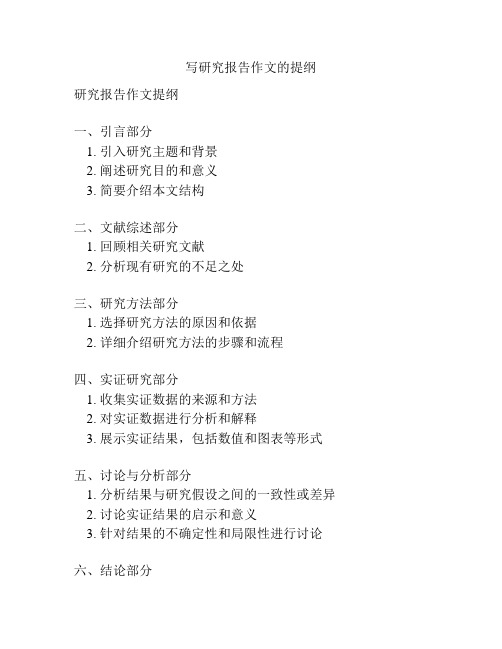
写研究报告作文的提纲
研究报告作文提纲
一、引言部分
1. 引入研究主题和背景
2. 阐述研究目的和意义
3. 简要介绍本文结构
二、文献综述部分
1. 回顾相关研究文献
2. 分析现有研究的不足之处
三、研究方法部分
1. 选择研究方法的原因和依据
2. 详细介绍研究方法的步骤和流程
四、实证研究部分
1. 收集实证数据的来源和方法
2. 对实证数据进行分析和解释
3. 展示实证结果,包括数值和图表等形式
五、讨论与分析部分
1. 分析结果与研究假设之间的一致性或差异
2. 讨论实证结果的启示和意义
3. 针对结果的不确定性和局限性进行讨论
六、结论部分
1. 总结研究的主要发现
2. 强调研究的创新之处
3. 提出进一步研究的建议
七、参考文献部分
1. 格式化引用所使用的文献
2. 建议包括近几年的学术期刊和会议论文
八、附录部分
1. 补充一些关键数据、图表或实证过程的细节
2. 提供研究工具或问卷调查等补充材料
以上是一个主要包括七个部分的研究报告作文的提纲,每个部分都应该有清晰明确的标题,以帮助读者快速了解研究报告的内容和结构。
在撰写研究报告时,可根据这个提纲进行详细的写作和组织,确保研究报告的逻辑清晰、内容完整。
英语论文提纲outline格式

OUTLINE NOTES Thesis statement:Japanese theater rose froma popular to elite and then returned to apopular art form.I.IntroductionII.Early theatrical formsA.BugakuB.SarugakuC.Primitive NohD.Authors and Audience III.Noh theaterA.AuthorsB.Props1.Masksa.womenb.demonsc.old men2.Structure of StageC.Themes1.Buddhist influence2.The supernaturalD.Kyogen interludesE.AudienceIV.KabukiA.AuthorsB.Props1.make-up2.special effectsC.Themes1.Love stories2.RevengeD.AudienceV.Bunraku(puppet)theaterA.AuthorsB.PropsC.Themes1.Love stories2.Historical romancesD.AudienceVI.Conclusion The thesis is stated in the first section,which is the introduction.The body follows the introduction,and breaks down the points the author wishes to make.Note that some section have subdivisions, others do not,depending on the demands of the paper.In this outline,II,III,&IV all have similar structure,but this will not necessarily be true for all papers.Some may only have three major sections,others more than the five given here.Your conclusion should restate your thesis, and never introduce newmaterialVEGETARIANISM: PRO AND CONT h esis statement: Increasing worldwide population and shrinking food supplies suggest that changes in food habits such as vegetarianism may be necessary for the survival of the human species. The advantagesand disadvantages or a vegetarian diet will be considered in this paper.I. There are many advantages to a vegetarian diet.A. Vegetarians ingest less fat and cholesterol and are therefore at less risk for heartdisease.B. Vegetarians eat mostly fresh vegetables and are therefore less likely to ingestcancerous agents such as preservatives.C. Given sufficient space, vegetarians can grow much of their own food, which is bothsafer and cheaper than buying it.D. Vegetarianism causes less damage to the environment.1. Vegetables require less fuel and water than cattle.2. Farmers could produce more food if they did not devote so much farmland tocattle.3. Vegetarians don't kill animals for food.II. There are also some disadvantages to a vegetarian diet.A. Care is needed to avoid protein and vitamin deficiencies.1. Vegetarians may need vitamin supplements.2. Vegetarians are at more risk for anemia than meat eaters.B. Vegetarian diets are not a varied as others.1. A complex combination of recipes is needed to keep the diet interesting.2. It is difficult to get much variety in textures and tastes.C. It is difficult to be a vegetarian in a meat-eating society.1. Vegetarians are often looked upon as cultists.2. Vegetarians are sometimes thought to be self-righteous.Traditional Alpha-NumericFormat I.Main point (or chapter)A.Support to main point 1.Evidence for point IA 2.More evidence for IA B.Second support for main point 1.Evidence for point IB a.support for this evidence b.more support for this evidence 2.More evidence for IB II.Second main point (and so on)Decimal Format1.0.Main point (or introduction to a chapter)1.1.First issue in this chapter 1.1.1.Evidence for point 1.11.1.2.More evidence for 1.11.2.Second issue in this chapter 1.2.1Evidence for point 1.21.2.1.1.support for this evidence 1.2.1.2.more support for this evidence 1.2.2More evidence for point 1.22.0.Second main point or chapter (and so on)A single entry under this system could look like this:II.A.1.b.iii.A single entry under this system could look like this:2.1.1.2.3.。
如何撰写毕业论文的实证研究方法部分

如何撰写毕业论文的实证研究方法部分在撰写毕业论文时,实证研究方法部分是非常重要的一部分。
它描述了你在研究中使用的方法和程序,以验证你的研究目标和问题。
本文将详细介绍如何撰写毕业论文的实证研究方法部分,并提供一些实用的建议。
一、引言实证研究方法部分是毕业论文的核心内容之一,它需要提供研究问题的上下文,并简要介绍你用于回答这些问题的研究方法。
引言部分应该始终具备以下几个方面:1. 研究目的和研究问题:明确你的研究目的和问题,说明你希望通过实证研究方法得出的结论。
2. 研究背景:提供研究背景和当前学术界对该问题的认识,说明你的研究填补了何种研究空白。
3. 研究方法的选择和理论基础:解释为何选择特定的实证研究方法,并陈述该方法的理论基础和优势。
二、研究设计在实证研究方法部分的研究设计中,你需要详细描述你的研究设计和可行性。
以下是一些要点:1. 研究类型:说明你的研究是基于观察、实验、调查还是案例研究等特定类型。
解释你为何选择该类型,并阐明它与解决研究问题的关联性。
2. 研究样本和数据来源:描述你选择的研究样本的特征,说明为什么这个样本是适合的,并解释你获得数据的来源。
可以提到调查问卷、实验记录或者是文献资料等。
3. 数据收集方法:具体描述你采用的数据收集方法,包括问卷调查、实验操作和文献综述等。
说明这些方法的可行性和有效性。
4. 研究变量和测量:列出你所研究的变量,明确它们的操作定义和测量方式。
可以包括数值分析、统计方法或者其他定性分析等。
5. 研究步骤和时间安排:给出研究的整体步骤和时间安排,包括实施研究的起止时间、各个阶段的工作内容及预计完成时间。
三、数据分析方法在实证研究方法部分的数据分析方法中,你需要详细描述你将使用的数据分析方法。
以下是一些要点:1. 数据清理和预处理:解释你将如何进行数据的清洗和预处理。
包括删除无效数据、填充缺失值、标准化数据等。
2. 数据分析方法:明确你将使用的数据分析方法和技术,例如描述性统计、回归分析、因子分析、内容分析等。
Topic 5 How to Write an Outline论文提纲怎么写

•
A thesis statement is usually put in front of your outline in a declarative form that summarizes the central idea of the paper you will write.
Samples of thesis statement
Sample of the decimal system
1.The two reasons for… 1.1 The first reason… 1.1.1 The women… 1.1.1.1They would… 1.1.1.2They could… 1.1.2 The men… 1.2 The second reason… 2.The reasons against…
Exercise of Outline Writing
Direction: Below is a part of an outline from a student’s paper. Read the following headings carefully and try to find what’s wrong with them and then correct the mistakes.
Topic 5 How to Write an Outline for Research Paper
When you build a house you should have a ground plan first and an outline is your ground plan for “building” your research paper.
Sample 2
论文设计提纲作文范文模板

论文设计提纲作文范文模板## 英文回答:Research Paper Outline Essay Template。
1. Introduction。
A brief overview of the topic。
A statement of the thesis statement。
A roadmap of the paper。
2. Background。
A discussion of the relevant literature。
A presentation of the current state of research。
An identification of the gap in the research。
3. Methods。
A description of the research design。
A detailed explanation of the data collection and analysis procedures。
4. Results。
A presentation of the findings from the data analysis。
A discussion of the implications of the findings。
5. Discussion。
An interpretation of the findings。
A consideration of the limitations of the study。
Suggestions for future research。
6. Conclusion。
A restatement of the thesis statement。
A summary of the main findings。
A discussion of the significance of the research。
Format。
实证研究报告提纲

实证研究报告提纲
一、研究背景
1.1 引言
1.2 问题陈述
1.3 目的和意义
二、文献综述
2.1 先前研究概述
2.2 相关理论和模型
2.3 理论缺口和研究价值
三、研究设计
3.1 研究方法与数据收集
3.2 研究样本
3.3 变量选取和操作定义
3.4 实证模型构建
四、实证结果
4.1 数据处理与分析方法
4.2 主要实证结果
4.3 敏感性分析与鲁棒性检验
4.4 结果解读和讨论
五、结论
5.1 研究问题回答和发现
5.2 研究局限和不足之处
5.3 研究对实践和理论的启示
六、参考文献
附录:数据收集工具、详细数据处理方法、实证模型详细推导等。
以上是一份实证研究报告的提纲,可以根据具体研究内容和需求进行具体的调整和修改。
实证研究报告一般需要对研究问题进行明确的陈述和概述先前的研究,构建合理的实证模型并进行数据的
收集和分析,最终根据实证结果对研究问题进行回答和讨论。
在报告中,应该对研究的创新和局限性进行明确的说明,并提出对实践和理论的有益启示。
最后,为了保证报告的完整性和可复制性,可以在附录中提供详细的方法推导和数据处理过程。
- 1、下载文档前请自行甄别文档内容的完整性,平台不提供额外的编辑、内容补充、找答案等附加服务。
- 2、"仅部分预览"的文档,不可在线预览部分如存在完整性等问题,可反馈申请退款(可完整预览的文档不适用该条件!)。
- 3、如文档侵犯您的权益,请联系客服反馈,我们会尽快为您处理(人工客服工作时间:9:00-18:30)。
Research Paper OutlineThe research paper outline is essential for any article or term paper. The outline may make a great difference on how your work is interpreted.Writing a research paper is as important as performing the actual research or experiment itself and can appear to be a very daunting task.It does not matter what conclusions you arrived at or how perfect your experimentation was, if you put no effort into writing a good report then your study will not be taken seriously.If you break report writing down into its constituent parts, it is not as complex as it seems and there is no reason to be worried. Scientific reports, for the vast majority of disciplines, are all structured in the same way; if you follow this structure then you cannot go far wrong.It is useful to note that every scientific discipline, every university and even supervisors can have their own preferred methods of constructing reports; with this in mind, do not be afraid to ask for advice on the best research paper format for your report.LAYOUT AND LENGTHFor most assessed reports you will be told how long it should be, generally by the number of words.This is generally only a guide and is not set in stone; in most cases this limit does not include appendices and citation pages.If you plan to write for a specific journal, a good advice is to check the research paper outline of some of the articles to get a better idea on how to write your article. Here are a few outline samples.If your report is complex and strays over this limit, there should be no problem, as long as you have not repeated yourself or filled your work with irrelevant information. It is good practice to bear in mind that the appendix is there for any information that you feel could be omitted from the report without affecting the clarity.Your report can be shorter than the advised word limit if everything that needs to be included is there. This is preferable than trying to pad out the report in order to fulfill some ‘word count’ facility on the computer, risking being penalized for irrelevance.For longer reports, it is useful to break each section down into subsections, to make your report more reader friendly and easier to navigate.BASIC STRUCTUREThe vast majority of scientific reports can be broken down into the following constituent parts.TITLE AND AUTHORSAlthough the title is the shortest page of your report, it is often the most difficult to write.It is important to make clear to a researcher everything that needs saying but without the title being overlong and unwieldy. It does not have to be the first section written because, in many cases, the final title will not occur to you until you have finished writing the report.Nowadays, most research establishments have a database to search titles by keyword so try to make sure that your title contains these. This is doubly important if your research is likely to be published on the internet.The authors section should include your name, as the main writer of the report, alongside the name of your supervisor. In the case of working as part of a team, you should usually include the other members of your group here.ABSTRACTThe abstract is the most crucial part of the report because anybody searching for your research on a database or in a journal will usually read only the abstract. Therefore, it must summarize your research, results and conclusions in less than 200 words.Sometimes it is good to think of it as a sample of your research rather than a review; it should inform the researcher that your article contains the information they need. There are a few ideas on how to write your abstract but the best advice is that you look at some journals relevant to your research and try to format your abstract in a similar way.CONTENTSThis section and is merely a breakdown of sections and subsections by page number. For a short and straightforward paper it may not be necessary to include a contents page.This is not mandatory for a research paper.INTRODUCTIONThis section of your report is where you will document all the painstaking research into the background of your experiment.The main thing to bear in mind, when writing the introduction, is that a scientist who is unfamiliar with your exact subject matter may be reading the article.It is important, therefore, to try and give a quick and condensed history of the research leading to your experiment, with correct citations.You should also give a little background on why you chose to do this particular experiment and what you expect to find. It is a little ‘old-fashione d’ to hypothesis statement at the beginning of the report but the reader should be aware of exactly what you are trying to prove.METHODFor this portion of your report you must describe the methods used when performing the experiment. This should include, if relevant, the location and times of sample collection, what equipment was utilized, and the techniques used.The idea behind the methodology section is that another researcher can exactly replicate your experiments without having to guess what equipment and what techniques should be used.Scientific articles are peer reviewed and this includes the possibility that other researchers may try to replicate your results.There have been many high profile scientific breakthroughs over the years whose results were unable to be repeated; these experiments were disregarded. For field studies you should give an exact map reference and time as well as including a map in the appendix.If you used complex machinery or computer programs in the course of your experiment, to avoid breaking the flow of your report, you should give only the main information and refer to the exact technical specifications in the appendix.RESULTSThese should be a quick synopsis of the facts, figures and statistical tests used to arrive at your final results.You should try to avoid cluttering up your report and insert most of your raw data into the appendix.It is far better to stick with including only tables and graphs that show clearly the results. Do not be tempted to insert large numbers of graphs and figures just for the sake of it; each figure and graph should be mentioned, referred to and discussed in the text.Try to avoid putting in tables and graphs showing the same information; select the type that shows your results most clearly. It is usually preferable to use graphs and relegate the tables to the appendix because it is easier to show trends in graphical format.Figures and graphs should be clear and occupy at least half a page; you are not a magazine editor trying to fit a small graph into an article.All such information must be numbered, as diagrams for graphs and illustrations, and figures for tables; they should be referred to by this number in the body of the report. You do not need to put the full breakdown of the calculations used for your statistical tests; most scientists hate statistics and are only interested in whether your results were significant or not. Relegate the calculations to the appendix.The results section of your report should be neutral and you should avoid discussing your results or how they differed from or compared with what was expected. This information belongs in the next section.DISCUSSIONThis is the pivotal section of your hard work in obtaining and analyzing your results.In your discussion you should seek to discuss your findings, and describe how they compared and differed from the results you expected. In a nutshell, you are trying to show whether your hypothesis was proved, not proved or inconclusive.You must be extremely critical of yourself in this section; you will not get marked down for mistakes in experiment design or for poor results, only for not recognizing them.Everybody who has written a dissertation or thesis has had to give a presentation to a room full of fellow students, scientists and professors and give a quick synopsis. These people will tear your report apart if you do not recognize its shortcomings and flaws.Very few experiments are 100 per cent correct in their design and conception so it is not really important what your results were, only that you understand their significance.Usually you will have had some promising results and some that did not fit with what you expected. Discuss why things may have gone wrong and what could be done to refine the results in future. Suggest what changes in experimental design might improve the results; there is no right or wrong in science, only progress.Finally, you can discuss at the end ideas for further research, either refining the experiment or suggesting new areas. Even if your paper was a one off, somebody may come along and decide that they find your research interesting and that they would like to continue from where you left off.SUMMARY AND CONCLUSIONThis is really just a more elaborate version of the abstract.In a few paragraphs you should summarize your findings. Your abstract will do most of this for you but, as long as you do not get carried away, especially for longer reports, it can help the reader absorb your findings a little more.REFERENCESInclude all of your direct references here, even if you only found a couple of sentences.In the case where somebody referred to an original source, reference that too, but if you did not manage to get hold of it, try to rewrite so that you will not have to reference (or use "referred in"-citation).ACKNOWLEDGEMENTSHere it is polite to acknowledge anybody who helped you with this report, although do not go overboard; it is not an Oscar speech.Your supervisor is a good start, as well as others who helped. If a landowner gave you permission to take samples then it is good practice to acknowledge them and give them a summary of your results, if permitted.APPENDICESAppendices are very useful because they give you a place to dump raw data and calculations. They must still be laid out correctly; the data must be relevant and referred to in the main report.If you have a lot of relevant photographs of sample sites and methods then they belong here. It is also useful to insert a Google map plan to show from where you took samples.FINAL THOUGHTSHopefully this will have given you a good oversight into writing that perfect report. It is not as daunting as it seems and if you do your research and listen to your supervisor then all should be well and you can get a good grade.Read more: /research-paper-outline.html#ixzz1m4BjXFjF。
